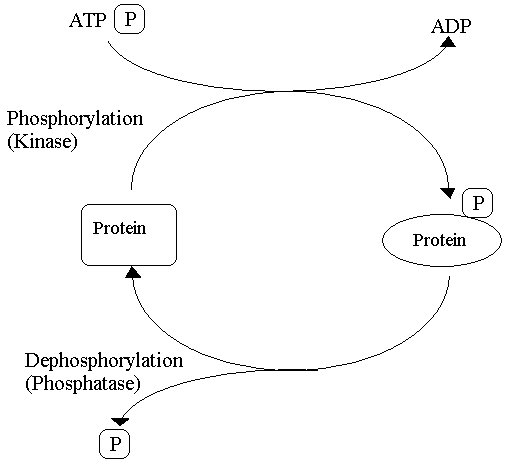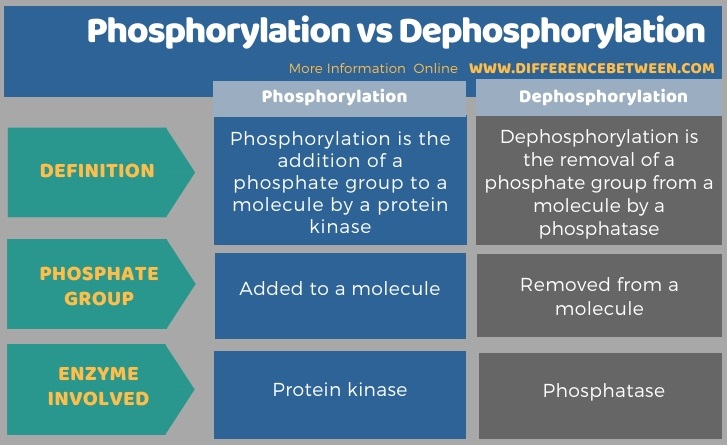The key difference between phosphorylation and dephosphorylation is that phosphorylation is the addition of a phosphate group to a molecule by protein kinase. Meanwhile, dephosphorylation is the removal of a phosphate group from a molecule by hydrolase, especially by a phosphatase.
Phosphorylation and dephosphorylation are two crucial processes in physiological processes of living organisms. Protein phosphorylation and dephosphorylation are very important for cell signalling, cell division, protein translation, metabolism and survival. In a cell, generally, more than 30% of proteins undergo phosphorylation. Most importantly, phosphorylation and dephosphorylation take place in all types of protein substrates such as structural proteins, enzymes, membrane channels, signalling molecules, etc. The regulation of phosphorylation and dephosphorylation reactions is collectively called phosphoregulation.
CONTENTS
1. Overview and Key Difference
2. What is Phosphorylation
3. What is Dephosphorylation
4. Similarities Between Phosphorylation and Dephosphorylation
5. Side by Side Comparison – Phosphorylation vs Dephosphorylation in Tabular Form
6. Summary
What is Phosphorylation?
Phosphorylation is the addition or transfer of a phosphate group to a molecule by an enzyme called protein kinase. It is a type of posttranslational modification. Generally, a phosphate group comes from ATP or from ADP. This process is commonly seen in many physiological processes occurring in living organisms, especially in regulating protein function, localization, conformation, interaction and clearance. Moreover, phosphorylation is critical in extracellular signalling. Neurotransmitters, hormones, cytokines, etc. produce their effects by regulating the phosphorylation in their target cells.

Figure 01: Phosphorylation
There are more than 200000 phosphorylation sites in the human genome. More than 500 different kinases are involved in the phosphorylation mechanisms.
What is Dephosphorylation?
Dephosphorylation is the counterpart of phosphorylation. Dephosphorylation refers to the removal of a phosphate group from a molecule, especially from an organic compound. It occurs via hydrolysis. Hydrolase, especially phosphatase, is the enzyme catalyzing the dephosphorylation. Similar to phosphorylation, dephosphorylation is important in many cellular processes. During phosphorylation, ATP is converted into ADP by releasing one phosphate group and energy. Removal of a phosphate group occurs via hydration reaction by addition of a molecule of water and regeneration of a hydroxyl group.

Figure 02: Dephosphorylation
Proteins are often subjected to dephosphorylation. Protein dephosphorylation is a key process in cell signalling. Moreover, dephosphorylation plays a big role in cloning using restriction enzymes. Dephosphorylating phosphatases prevent re-ligation.
What are the Similarities Between Phosphorylation and Dephosphorylation?
- Dephosphorylation is the counterpart of phosphorylation.
- In both processes, phosphate groups are involved.
- Also, they are enzyme catalyzing reactions.
- And, both reactions are reversible.
- Besides, both processes can be used to activate or deactivate a protein.
- They are important posttranslational modifications.
What is the Difference Between Phosphorylation and Dephosphorylation?
Phosphorylation is the addition of a phosphate group to a molecule by protein kinase, while dephosphorylation is the removal of a phosphate group from a molecule by a phosphatase. So, this is the key difference between phosphorylation and dephosphorylation. Furthermore, phosphorylation is catalyzed by the protein kinases while dephosphorylation is catalyzed by the phosphatases.
Below infographic summarizes the difference between phosphorylation and dephosphorylation.

Summary – Phosphorylation vs Dephosphorylation
Phosphorylation and dephosphorylation are two processes that are critical for all types of physiological processes. In phosphorylation, transferring of a phosphate group to a molecule takes place. The opposite reaction takes place in dephosphorylation. A phosphate group is removed from a molecule in dephosphorylation. So, this is the key difference between phosphorylation and dephosphorylation. However, both reactions are reversible. Moreover, enzymes are essential in catalyzing both types of reactions. Protein kinases catalyze phosphorylation, while phosphatases catalyze dephosphorylation.
Reference:
1. “Dephosphorylation”. En.Wikipedia.Org, 2020, Available here.
2. Nestler, Eric, and Paul Greengard. “Protein Phosphorylation Is Of Fundamental Importance In Biological Regulation”. Ncbi.Nlm.Nih.Gov, 2020, Available here.
Image Courtesy:
1. “GSK3 phosphorylation” By Hyou at English Wikibooks – Transferred from en.wikibooks to Commons., Public Domain) via Commons Wikimedia
2. “Reversible phosphorylation” (CC BY-SA 3.0) via Commons Wikimedia
ncG1vNJzZmivp6x7pbXFn5yrnZ6YsqOx07CcnqZemLyue8OinZ%2Bdopq7pLGMm5ytr5Wau268x6iqqaCfp8atrdOipqdlkaOxbrDEqZ%2Boq6CdvLPFy5qroqeeZA%3D%3D